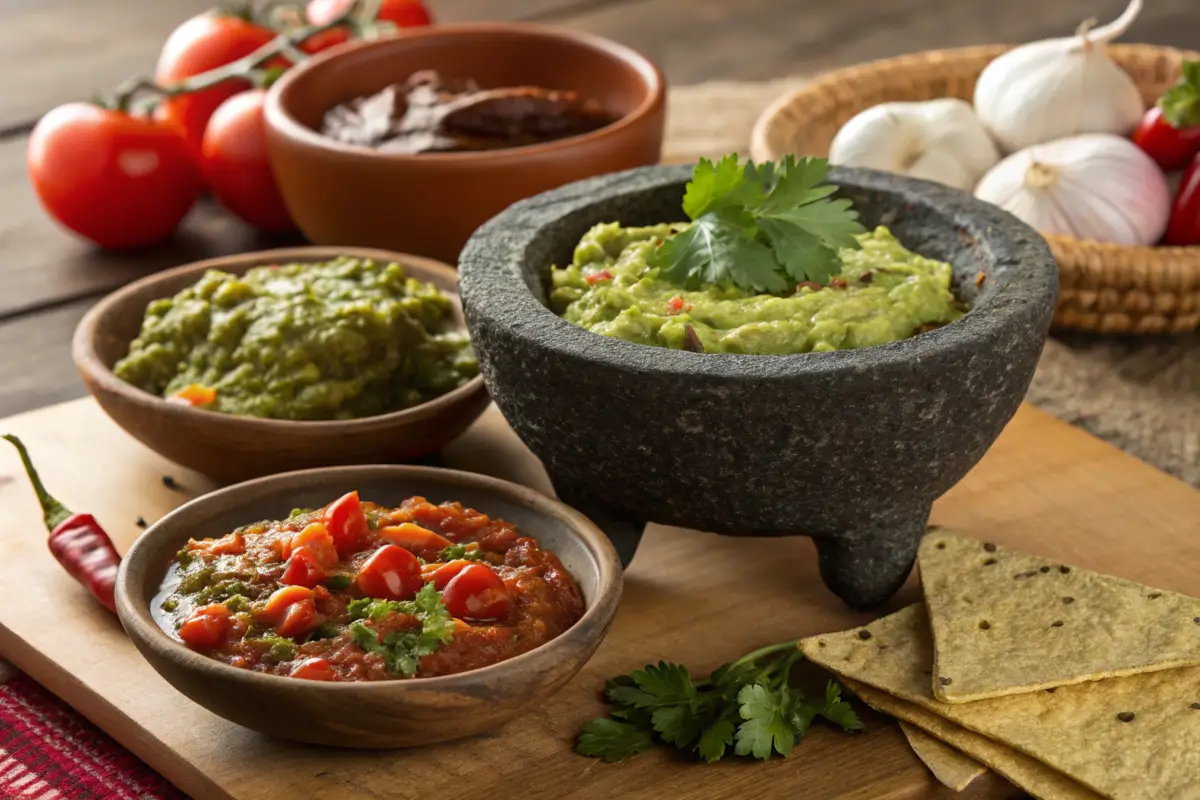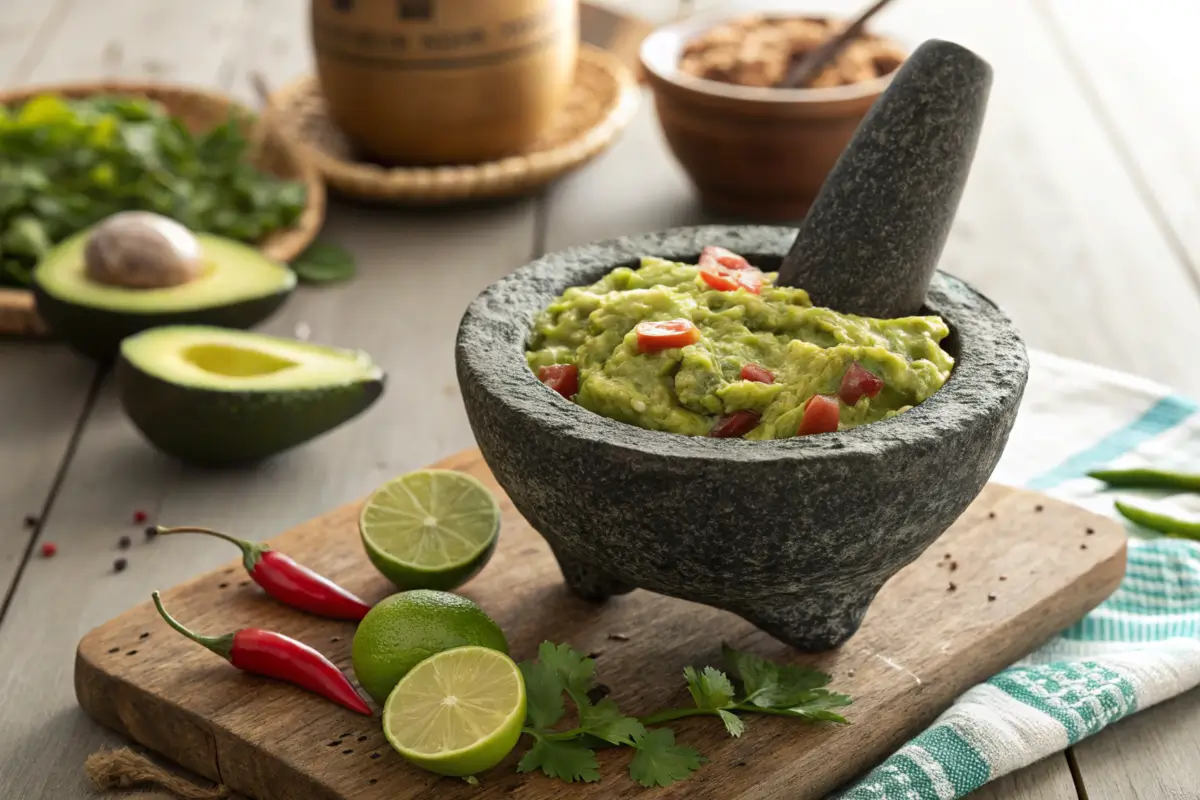Traditional molcajetes have long been a cornerstone of Mexican cuisine, preserving the flavors and textures that modern kitchen tools often fail to replicate. What is a traditional molcajete made of? Primarily crafted from volcanic rock, these handcrafted tools play a pivotal role in preparing dishes like guacamole, salsas, and spice blends. Beyond their practical use, they carry a deep cultural and historical significance, reflecting centuries of tradition. This article delves into the materials, craftsmanship, and cultural essence of traditional molcajetes, highlighting why they remain irreplaceable in kitchens worldwide.
Introduction to the Molcajete
What is a Molcajete?
The word molcajete might sound exotic, but it refers to a humble yet powerful kitchen tool. A molcajete is essentially a traditional Mexican mortar and pestle, used to grind and mix ingredients. The name originates from the Nahuatl words molli (meaning sauce) and caxitl (meaning bowl). Unlike the smooth marble or ceramic mortars found elsewhere, a molcajete boasts a rough texture ideal for pulverizing even the toughest ingredients.
These tools date back to ancient Mesoamerican cultures, including the Aztecs and Maya, who relied on them to prepare staple dishes. The accompanying pestle, known as a tejolote, is perfectly shaped to fit the bowl, making it easy to crush spices, seeds, and herbs into a rich, flavorful paste. While modern kitchen gadgets can mimic its function, they can’t match the molcajete’s authenticity and flavor-enhancing properties.
Origins and Historical Significance
A traditional molcajete isn’t just a kitchen tool; it’s a testament to Mexico’s culinary heritage. Archaeological evidence suggests that early forms of the molcajete were in use over 3,000 years ago. Made by skilled artisans, they were carved from volcanic rock, a material abundant in the region and prized for its durability.
The tool was more than functional; it symbolized connection—between people, food, and the earth. Many families passed their molcajetes down through generations, embedding them with memories and flavors. Whether preparing salsas for celebrations or grinding spices for everyday meals, the molcajete stood as a cornerstone of communal and cultural identity.
The Traditional Materials of a Molcajete
Volcanic Rock: The Key Ingredient
When discussing what is a traditional molcajete made of, volcanic rock stands out as the primary material. This porous, coarse-textured rock is more than just a practical choice—it’s the backbone of a molcajete’s functionality. Found abundantly in Mexico due to the region’s volcanic activity, this material provides the necessary grit for crushing and grinding ingredients effectively. The rough surface of volcanic rock creates the perfect friction for breaking down spices, seeds, and herbs, ensuring maximum flavor extraction.
Unlike smooth mortars made from marble or ceramic, volcanic rock molcajetes enhance the preparation process, leaving you with rich, authentic flavors. The tiny pores in the rock also help absorb oils and essences over time, embedding a unique seasoning into the tool itself. Every use enriches the molcajete, turning it into a true kitchen heirloom.
Why Volcanic Rock? Properties and Benefits
What makes volcanic rock so special? For starters, it’s incredibly durable and heat-resistant. This makes it ideal for both cold and hot preparations. From grinding chilies to serving sizzling fajitas, a volcanic rock molcajete holds its own in any kitchen scenario.
The rock’s natural texture aids in pulverizing ingredients without slipping. Additionally, its porous nature helps retain the flavors of past preparations, infusing them subtly into future dishes. This unique characteristic ensures every salsa or guacamole you make tastes more authentic and layered.
How Traditional Molcajetes are Made
The Crafting Process: From Rock to Tool

The creation of a molcajete is as fascinating as its use. To craft one, artisans carefully select high-quality volcanic stones, ensuring they’re free of major cracks or inconsistencies. Using traditional tools and techniques, they chisel the rock into a bowl shape, achieving the perfect balance of depth and texture.
The accompanying tejolote (pestle) is shaped to fit snugly in the molcajete, ensuring an ergonomic grip for grinding. Crafting a molcajete requires precision and patience, as even the smallest imperfection can impact its functionality. Many skilled artisans in Mexico pass down their techniques through generations, preserving the art of molcajete-making.
Artisan Techniques in Mexico
In regions like Jalisco and Puebla, molcajete crafting is a revered art. Artisans often work in small workshops, where each molcajete is handcrafted with care. These pieces are not just tools—they’re expressions of cultural heritage and craftsmanship. Many molcajetes are adorned with carvings or patterns, adding a touch of artistry to their utility.
Modern vs. Traditional Manufacturing Methods
While traditional molcajetes are carved entirely by hand, modern versions may involve machinery. However, machine-made molcajetes often lack the same quality and character. Authentic, handmade molcajetes retain the irregularities of volcanic rock, which are key to their effectiveness.
For readers interested in using molcajetes for authentic Mexican recipes, check out this guide to making traditional molcajete salsa. This link offers insights into recipes that celebrate the true essence of this iconic tool.
Culinary Uses of a Traditional Molcajete
Staple Mexican Dishes Made in Molcajetes
The traditional molcajete isn’t just a kitchen tool—it’s a culinary treasure. It has been instrumental in creating iconic Mexican dishes like guacamole, salsas, and mole. The rough texture of volcanic rock allows ingredients to blend together naturally, extracting bold flavors and rich textures. Whether it’s a tangy tomatillo salsa or a creamy guacamole, the molcajete elevates the taste in a way modern gadgets simply can’t replicate.
Moreover, molcajetes can be used for dishes beyond sauces. Many households serve sizzling fajitas or seafood stew in these stone bowls, where the natural heat-retention properties of volcanic rock keep the food warm and flavorful. Imagine the aroma of a freshly prepared salsa, ground to perfection in a molcajete—there’s nothing quite like it!
Why Molcajetes Are Preferred Over Modern Tools
With modern blenders and food processors readily available, you might wonder why the molcajete is still so beloved. The answer lies in its authenticity and performance. A molcajete grinds rather than chops, preserving the natural textures and flavors of ingredients. Unlike mechanical tools, it doesn’t generate heat that can dull flavors.
In addition, the porous volcanic rock subtly seasons over time. This unique quality ensures each preparation builds on the last, creating complex layers of flavor that enrich every dish. For food enthusiasts passionate about tradition, the molcajete is irreplaceable.
Curious about how to use a molcajete for authentic Mexican flavors? Check out our guide on crafting the perfect molcajete salsa here.
Famous Recipes: Guacamole, Salsas, and More

One of the most popular uses for a molcajete is making guacamole. The stone texture mashes avocados into a creamy base while leaving small chunks for added texture. Salsas also benefit immensely, as grinding chilies, tomatoes, and spices brings out their natural oils and flavors.
Beyond dips, molcajetes are often used to grind spices for mole—a rich, complex sauce central to Mexican cuisine. They can even double as serving bowls for hot dishes like soups or grilled proteins, making them versatile kitchen companions.
Maintaining and Seasoning a Molcajete
Why Seasoning Is Essential for a Molcajete
A new molcajete requires proper seasoning before its first use to remove any gritty volcanic rock dust and prepare the surface for cooking. Seasoning not only ensures a smoother grinding process but also enhances the tool’s ability to absorb flavors over time. It’s a crucial step for anyone asking, What is a traditional molcajete made of? Proper seasoning transforms the raw volcanic rock into a reliable kitchen ally.
Step-by-Step Guide to Proper Seasoning
- Rinse and Clean: Start by rinsing the molcajete and pestle with water. Avoid using soap, as its residue can seep into the pores of the rock.
- Grind Raw Rice: Place a handful of uncooked rice in the bowl and grind it with the pestle until the powder becomes white and smooth. This process removes loose rock particles.
- Add Garlic and Salt: Once the rice grinding is complete, mash garlic cloves with coarse salt. This step helps season the rock with natural flavors.
- Rinse and Repeat: Rinse the molcajete with water, and repeat the grinding process if needed.
Cleaning and Maintaining Your Molcajete
To maintain your molcajete, always clean it immediately after use. Rinse with warm water and scrub with a stiff brush. Never use dish soap, as it can absorb into the porous volcanic rock and affect the flavor of future dishes. Let it air dry completely before storing to prevent moisture buildup.
Cultural Significance of Molcajetes
Symbol of Mexican Heritage and Tradition
Molcajetes are more than mere kitchen utensils; they are iconic symbols of Mexican heritage and tradition. For generations, these tools have been central to Mexican cuisine, embodying the essence of cultural identity. When you consider what is a traditional molcajete made of, it’s not just about volcanic rock—it’s about a piece of history. The craftsmanship involved in creating a molcajete reflects the skills passed down through centuries. Moreover, using a molcajete connects people to their ancestors, preserving age-old culinary practices that define Mexican culture.
Role in Festivals and Celebrations
During festive occasions and celebrations, molcajetes take center stage in Mexican households. Families gather to prepare traditional dishes, and the molcajete becomes a communal tool that brings everyone together. For instance, during Día de los Muertos (Day of the Dead), salsas and moles made in molcajetes honor the memories of loved ones. Furthermore, the act of grinding spices and ingredients by hand adds a layer of authenticity and love to the food. The presence of a traditional molcajete made of volcanic rock enriches these celebrations, bridging the gap between past and present.
Molcajetes in Modern Mexican Households
In today’s fast-paced world, many might assume that traditional tools have lost their place. However, molcajetes remain cherished in modern Mexican households. Despite the availability of blenders and food processors, people still prefer the molcajete for its ability to enhance flavors uniquely. Additionally, there’s a growing appreciation among younger generations for traditional cooking methods. By using a molcajete, they not only create delicious meals but also keep their heritage alive. So, when someone asks what is a traditional molcajete made of, it’s an invitation to explore a rich cultural legacy that continues to thrive.
FAQs
What Are the Alternatives to a Traditional Molcajete?
If you don’t have a traditional molcajete made of volcanic rock, there are alternatives you can use. A granite mortar and pestle can serve a similar purpose, allowing you to grind ingredients effectively. Additionally, a food processor or blender offers convenience, though they might not deliver the same texture or depth of flavor. Nevertheless, while these substitutes are handy, they may lack the authentic touch that a molcajete provides.
Is Every Molcajete Made of Volcanic Rock?
Not every molcajete is made of volcanic rock, but the traditional ones are. Some modern versions use materials like granite, basalt, or even ceramic. However, volcanic rock is preferred because its porous surface enhances grinding and releases natural minerals into the food. This unique feature contributes to the distinctive flavors in traditional Mexican dishes. Therefore, if authenticity is important to you, opting for a molcajete made of volcanic rock is the way to go.
How to Identify an Authentic Molcajete?
Identifying an authentic molcajete involves a few key observations. First, examine the texture—it should be rough and grainy due to the porous volcanic rock. Second, the weight will be substantial, reflecting the density of the material. Additionally, authentic molcajetes are often hand-carved, so slight imperfections are normal and add to their charm. If possible, purchase from reputable vendors who specialize in traditional Mexican cookware to ensure you’re getting the real deal.
How Long Does a Traditional Molcajete Last?
A traditional molcajete can last a lifetime, and often even longer. Made from durable volcanic rock, these tools are incredibly resilient. With proper care and maintenance, such as regular cleaning and occasional re-seasoning, your molcajete will remain in excellent condition. In fact, many families pass down their molcajetes through generations, turning them into treasured heirlooms. So, investing in a quality molcajete means you’ll have a reliable kitchen companion for years to come.

